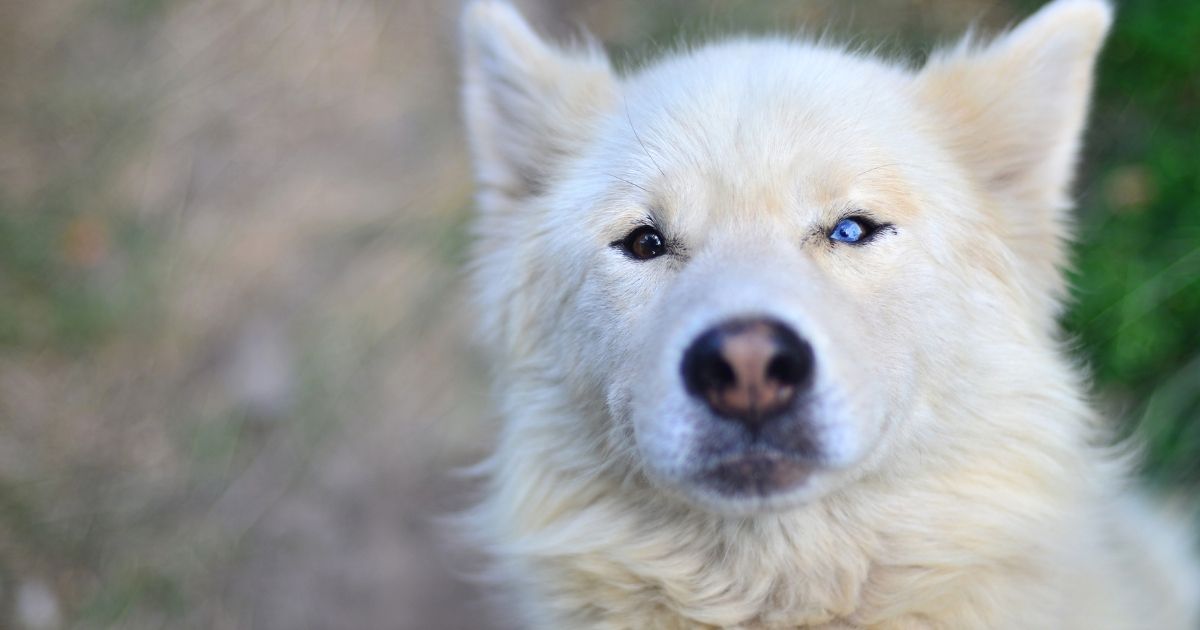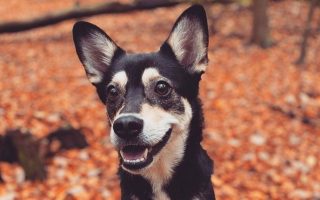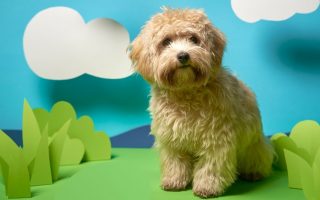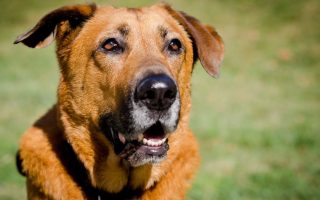The Samoyed Husky Mix (also Samusky, Samsky) is a cross between the Samoyed and the Siberian Husky.
It must have existed longer than many other designers breeds as it is believed that both parent breeds were mixed in the late 1990s.
The breeders aimed to get a hybrid with the Husky’s loyalty and the Samoyed’s social nature.
It is a mixed breed in high demand as it tends to get the best from both parents, including a high level of intelligence.
In appearance, this mixed breed has the looks of an arctic fox. Luckily for it, its parents have a similar appearance.
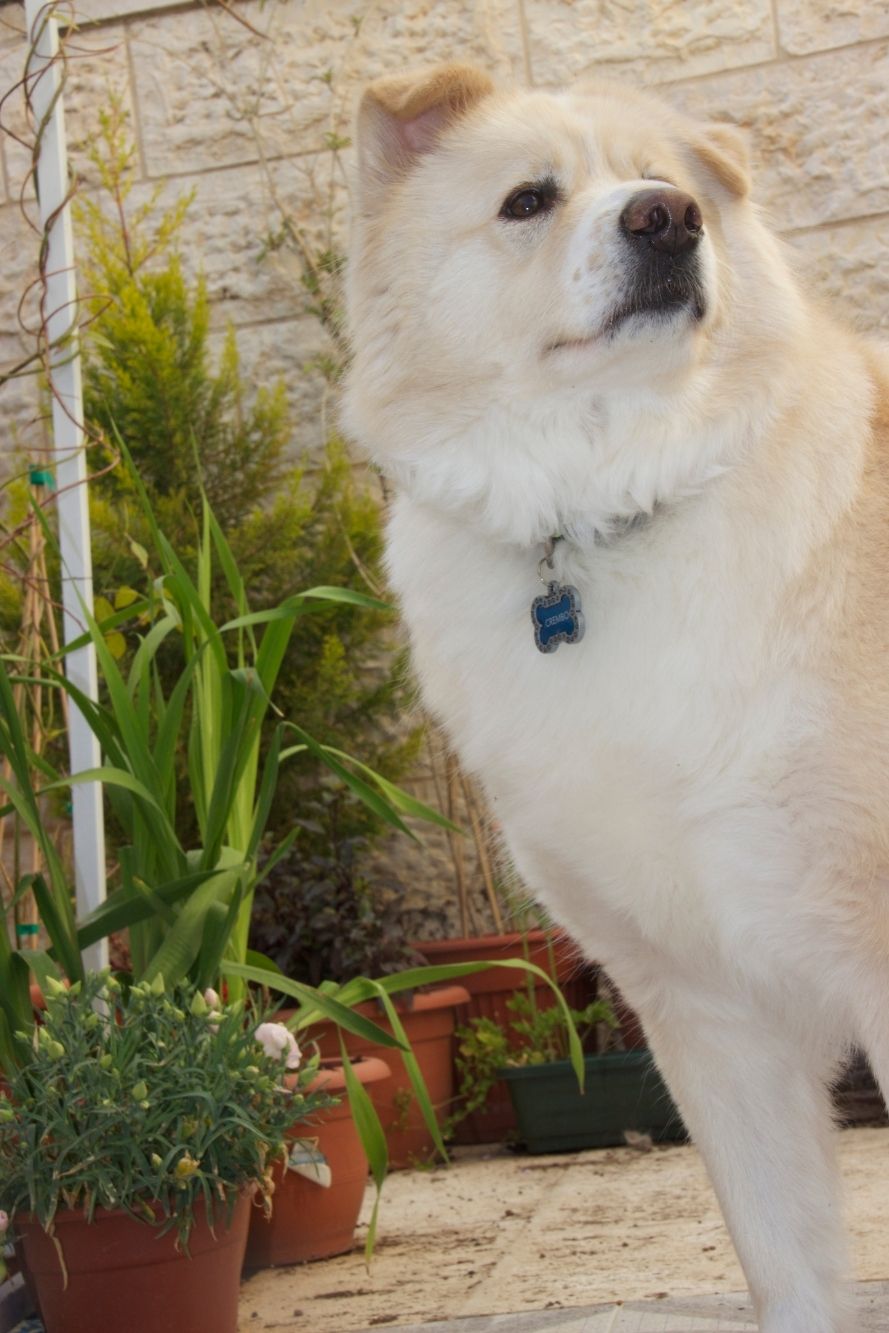
To own this breed, ensure you have the right environment and that you live the right lifestyle for it.
It also has needs similar to other canines that the owner should be able to handle.
This guide will give you all you should know about the Samusky.
Samusky Mixed Breed Information
| Height | 20 to 24 inches |
| Weight | 45 to 60 pounds |
| Lifespan | 12 to 15 years |
| Coat | Double, thick |
| Colors | Fawn, cream, white, agouti, gray, red, sable |
| Temperament | Loyal, social, stubborn |
| Ideal For | Experienced pet parents, owners with space |
| Puppy Price | $350– $1200 |
Samoyed Husky Mix Puppy Characteristics

| Health | High |
| Grooming | High |
| Friendliness | High |
| Energy | High |
| Trainability | Medium |
The Parent Breed
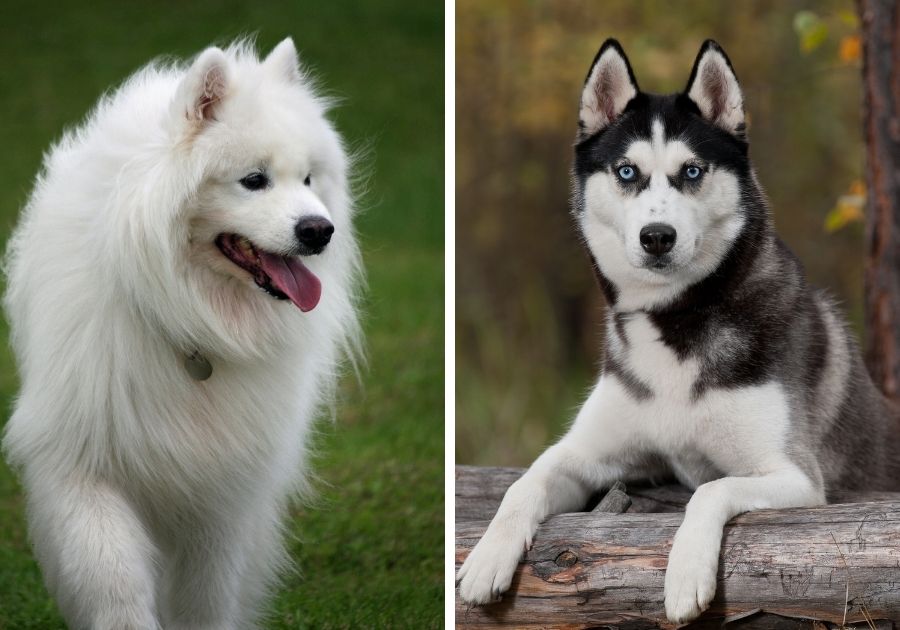
Samoyed
The Samoyed is an artic dog breed that originated in Siberia, a companion for the Samoyede people from whom it got its name.
During its early days, it played many roles for its people. These include hunting, pulling sleds, herding reindeers, and keeping its owners warm.
The dog breed was free with the Samoyede, and participated in many family activities.
In the early 20th century, it went on some dangerous expeditions in Polar Regions.
The first Samoyed to come into the western world was Antartic Buck.
In 1906, it made its way to America and was recognized the same year.
The Samoyed is a medium-sized dog breed weighing around 50 to 60 pounds. Its height range falls at 1 ft. 7 in. to 2 ft.
It has a dense, double coat with a coarse top coat and a shorter undercoat.
Its predominant color is white, but it comes with a biscuit color too. It has brown or black eyes, erect ears, and a curly tail.
The wonderful traits of this breed include gentleness, loyalty, and strong affection.
Just as it related with the Samoyedes of old, it loves being around family. The Samoyed is intelligent too but can be stubborn during training.
Siberian Husky
The Siberian Husky and the Samoyed have a lot in common.
One such similar point is their origin as Huskies also originated from Siberia.
They belonged to a tribe (the Chukchi) and played almost the same roles as the Samoyed.
In 1908, they came into the United States for the gold rush. The last of them left Siberia in 1930.
The same year, this breed was recognized by the American Kennel Club.
Another similarity between the Samoyed and the Siberian Husky is in appearance.
Sometimes, they get confused with each other.
The Husky also has a double coat with a particular shedding season. Its coat isn’t all white like the Samoyed though.
Huskies have a variety of colors like black, agouti, gray and white, black and tan, cream, and red and white.
The Husky is a medium-sized breed, but smaller than the Samoyed. It weighs 35 to 60 pounds with a height of 20 to 23 inches.
The Siberian Husky is friendly, loyal, and affectionate. It loves to be around family and is known as a pack dog.
It can be stubborn too during training but is intelligent enough to learn fast.
Facts about the Samoyed Husky Mix You Should Know
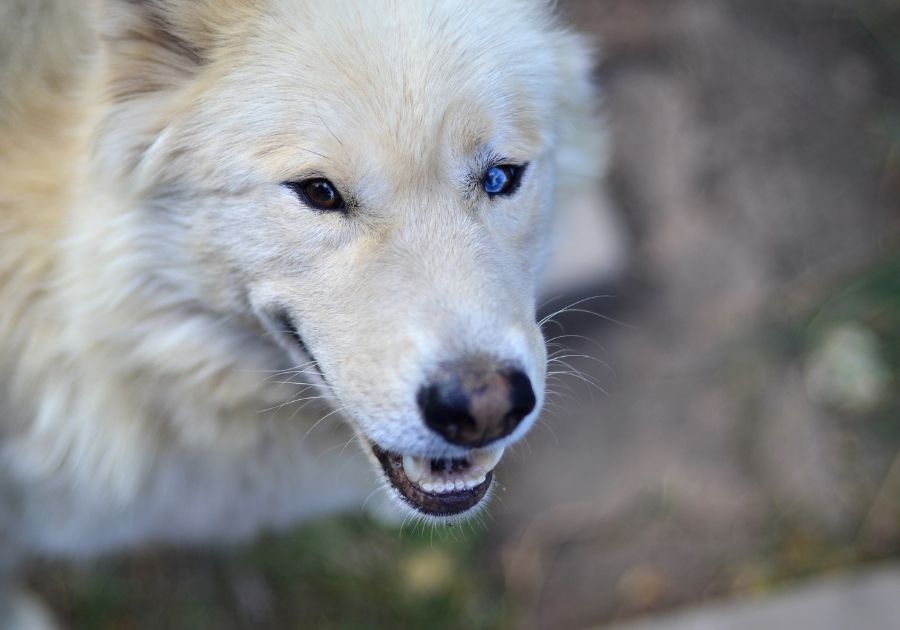
1. It is not a good choice for new pet parents
It isn’t hard to fall in love with this mix and to consider it fitting for your first pet parenting experience.
However, you should go for a breed that’s easier to train as the Samusky presents many training challenges that may frustrate a novice.
It is both stubborn and used to thinking for itself. Thus, it will find it difficult to listen to you.
It may also attempt taking over as leader of the pack if you let it. Only with consistency, patience, and experience can you train this breed.
2. Samusky is not recommended for allergy sufferers
Though this mix is considered hypoallergenic, it sheds little all year round and has seasons when it ‘blows over’, leaving the entire environment with dog fur.
Someone prone to canine allergies may not find the environment comfortable during these seasons.
Therefore, it is not recommended for owners with allergies.
3. It can tolerate cold weather
The undercoat of this mix shields it from the cold, a good advantage for its parents in the strong Siberian weather.
However, you shouldn’t expose these hybrid dogs to extreme cold for a long period.
Special considerations should also be looked into during the summer and warmer weather. Thy aren’t a fan of the heat either.
4. Samusky is a maintenance breed
Grooming this mixed breed requires more effort than many other breeds out there.
That being said, it is a job you can undertake on your own.
This is a clean breed that hardly gets dirty. The biggest work you would have is in coat care.
5. It looks wild
Some will think it is a wolf dog, others may liken it to a fox or a coyote.
Either way, this Mix has the wild looks of both parents that may intrigue or scare away people.
Enthusiasts love how the wild looks draw them back to nature.
This is the biggest reason for the rising popularity of this crossbreed.
Appearance of the Samoyed and Siberian Husky Crossbreed
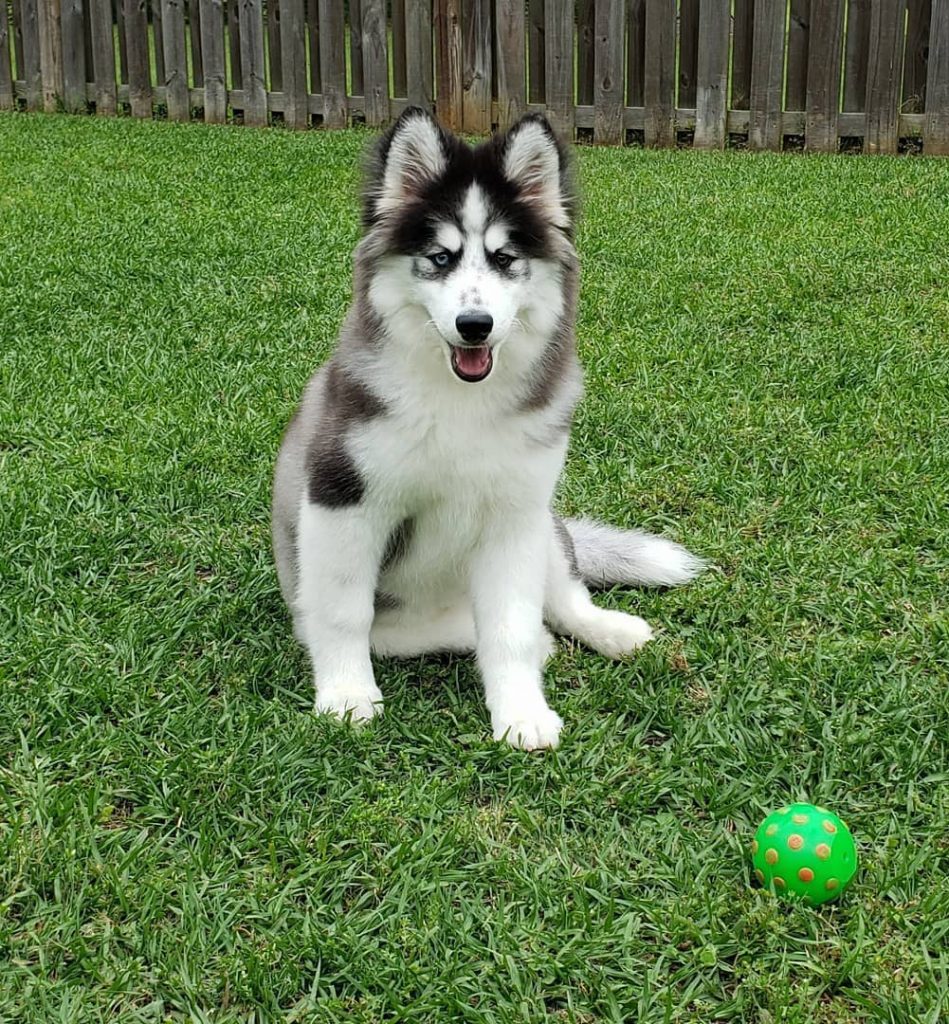
General Appearance
As earlier mentioned, Samuskies have the good fortune of parents with similar looks.
Although there are no kennel club standards, members of this breed tend to resemble.
They will always have erect ears, a sharp nose, a slim body, blue or brown eyes, and a curly tail.
Their faces will remind you of a fox or a wolf, and they have runners’ limbs that enable them to run for long.
Size
Like its parents, this mix is usually medium-sized.
There are no fixed standards for size too, but it is easier to predict with the Samusky than with other designer breeds.
It often weighs 45 to 60 pounds and grows from 20 to 24 inches.
Colors and Coat Type
The mix inherits from both parents a double coat that is dense and fluffy.
The topcoat is usually coarse and covers a softer undercoat.
The colors you could find on this breed include cream, fawn, agouti, gray, red, and sable.
Temperament, Behavior & Intelligence of the Samoyed Husky Mix
Having two loyal parents is a gift as this mixed breed is the doggy postcard for loyalty.
When well-bred and trained, it is faithful, devoted, and affectionate to its family members.
It is social with strangers, a trait that makes it a poor guard dog regardless of its fierce looks.
It makes a good watchdog though, as it can alert you of a stranger at the doorstep.
It also has some spunk and is true eye candy.
Expect to answer many questions from curious passersby and fellow dog lovers as it is easy to get enamored by this mix.
Far from being a loner, it loves both human and canine company.
These dogs sometimes forget they are medium-sized as they attempt climbing on their owner’s laps.
Samuskies have favorites, so don’t be surprised when your mix sticks to a particular member of the family.
It may be you, your spouse, or one of your children.
It loves everyone, though, and won’t miss the chance to play games with the family.
Some other traits to bear in mind are this breed’s intelligence and energy.
It needs enough mental stimulation and physical activities to be satisfied.
Lack of sufficient activities will make it bored, restless, and more likely to engage in destructive behaviors.
Boredom also turns it into a Houdini, and it is hard to catch it once it escapes.
Are Samoyed and Husky Mix Good Family Dogs?
The Samoyed Husky mix is a cute, ideal family dog if you can provide enough space for it and give it the adequate amount of exercise it needs.
You should also know how to handle its training demands if you want it to be well-mannered.
With all these in place, you will have a loyal, gentle and affectionate household pet who will love to snuggle or play.
It is kid-friendly too, though it is more recommended for a home with older kids who know how to treat a dog well.
Are they Good with Other Dogs & Pets?
The parents of this breed are both pack animals, so it is easy for them to get along with other pooches.
This doesn’t cancel the need for socialization, however.
You also need to introduce it slowly to other pets like cats and rabbits for peaceful coexistence.
How Much Does a Samoyed Husky Mix Puppy Cost?
The Samusky is not too expensive, though it largely depends on the breeder and the pedigree as some are highly expensive.
In general, the regular pup costs around $350 to $1,200. It is cheaper than both the Samoyed and the Husky.
The former costs between $600 and $1,500 while the latter often gets up to $1,300.
Some breeders may sell to you at a price cheaper than we’ve mentioned, but you should be wary of cheaper pups as they may be poorly bred or have hidden health issues.
This doesn’t mean you should trust the expensive breeders offering a Samoyed Husky mix for sale.
Your best bet is a reputable breeder who knows his/her pups.
This breeder should be willing to answer your questions, show you the environment where the pups are bred, and present the medical records of the pup you want to buy.
Only then should you make a purchase. You can find this mix with breeders who sell Samoyeds and Huskies.
Care to adopt?
Though this is a designer breed, you can also find it in rescue shelters, particularly those with Huskies and Samoyeds.
If adoption is your preferred option, then go for it. It is cheaper than shopping.
Having said that, be sure to get every information on the pup you wish to adopt. Many have backstories.
Caring for a Samusky Mixed Dog
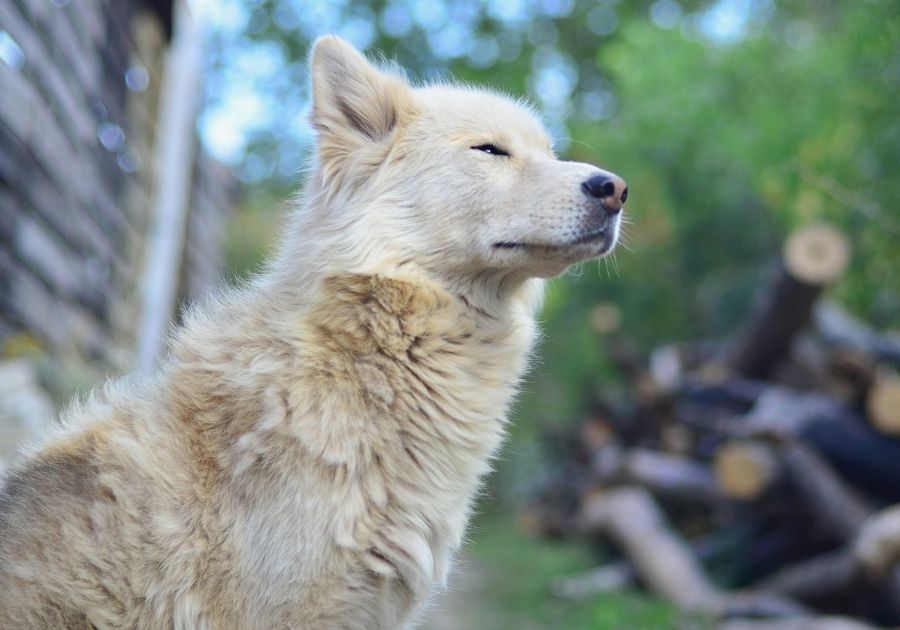
Food & Diet
The Samoyed and Husky mixed dog needs a rich diet but in moderation, as it tends to gain weight if overfed.
Some of these dogs are picky while others have a large appetite.
Your dog’s eating habits should be taken into account as you establish a feeding schedule.
Its diet should be of high quality but low in calories.
Besides feeding habits, age, size, and activity level matter in feeding this mixed breed.
The feeding requirement will change as the years go by.
A Samusky that’s obese will need fewer meals, and more active dogs require a bigger amount of food.
This mix should not be deprived of protein as that is the most important nutrient for dogs of all ages.
Minerals and a low amount of fat are necessary, as well as a few carbs for energy.
This mix is prone to hip dysplasia and other issues, so it should be given probiotics to help strengthen its bones.
Do not feed it grainy products because it would result in digestive problems.
Other forbidden meals include grapes, citrus fruits, and prunes.
Exercise
The highly energetic Samoyed and Siberian Husky crossbreed requires at least 30 minutes to an hour of daily physical and mental activities.
This helps maintain health, creates a bond between you and your pet, and curbs destructive behaviors.
Exercise also doubles as training.
Physical activities for the mix involve walking, running, games like fetch and frisbee, etc.
During warm weather, be watchful for overexertion and make sure the breed stays hydrated after every session.
In addition to physical activities, this intelligent breed should also be made to think with mental games like puzzles, tricks to learn, and hide and seek.
Without mental exercise, it is liable to boredom.
The mental activities must be challenging and interesting to hold the interest of this easily distracted breed.
Like feeding, age, size, and activity level influence the exercise needs of a particular Samusky.
Here, you may face some challenges as this breed isn’t very easy to train.
That said, it is trainable and has the eager to please nature of the Samoyed.
The setback you may encounter is the stubbornness it gets particularly from the Husky.
These dogs may challenge your authority sometimes.
This is why the ideal owner should be skilled and confident in handling a dog. The timid pet parent may lose control, a recipe for disaster.
As usual, training works best when you start it early enough.
Pups are easier to mold and they are less stubborn at that age, so that is the best time to inculcate good doggy habits in this mix.
If you wait till it becomes an adult before you train, you may find it harder to rework some bad behaviors it might have picked up.
Puppyhood is also the right time to establish yourself as leader of the pack.
This mix is a pack animal that needs an alpha it can respect. The only way you can succeed in training it is if you become that alpha.
One way you can show that you are in charge is by feeding your pup after you’ve eaten.
You should also show not let it sleep on the same bed with you, nor should you let it indulge in any bad behavior.
We do not advise you to use harsh treatment as that may be harmful. A simple rebuke is enough.
Take your puppy through obedience training, socialization, leash training, amongst others.
Grooming Needs
This high-maintenance breed requires more effort in taking care of its coat, especially during shedding seasons.
Normally, its coat should be brushed weekly to clear off any dirt or debris.
During shedding season, however, brush its coat daily to remove dead fur.
You should also have a vacuum cleaner in place to keep your environment neat.
This mix is a neat one, so bathing should not be regular. It hardly has any bad odor and may need bathing only when it gets stained.
While bathing, use a shampoo that’s convenient for its skin.
Other forms of hygiene include tooth brushing, nail trimming, ear, and eye cleaning.
Health & Conditions
This hybrid inherited healthy genes from both parents. With a long life span that gets up to 15 years, this is a pet you will have for a long time.
Getting a well-bred pup is essential, as well as taking care of its basic needs. Regular checkup is important as well.
Having said that, this breed is susceptible to some conditions. They include:
- Hip Dysplasia: This occurs as the dog is growing and is often inherited. Hip dysplasia is the loosening of the hip joint which can further deteriorate. This Mix and its parents are prone to hip dysplasia.
- Diabetes: Diabetes manifests in dogs in the same way as humans. It is caused by a lack of insulin in the dog’s body or a malfunction in the use of the insulin. It has no cure.
- Hyperthyroidism: Hyperthyroidism happens when the dog produces an excess of the thyroid hormone in the dog’s body. It leads to fatigue and excess weight gain.
- Eye Defects: Many eye issues can affect dogs. For this Mix, the most common are cataracts, Progressive Retinal Atrophy, and corneal dystrophy.
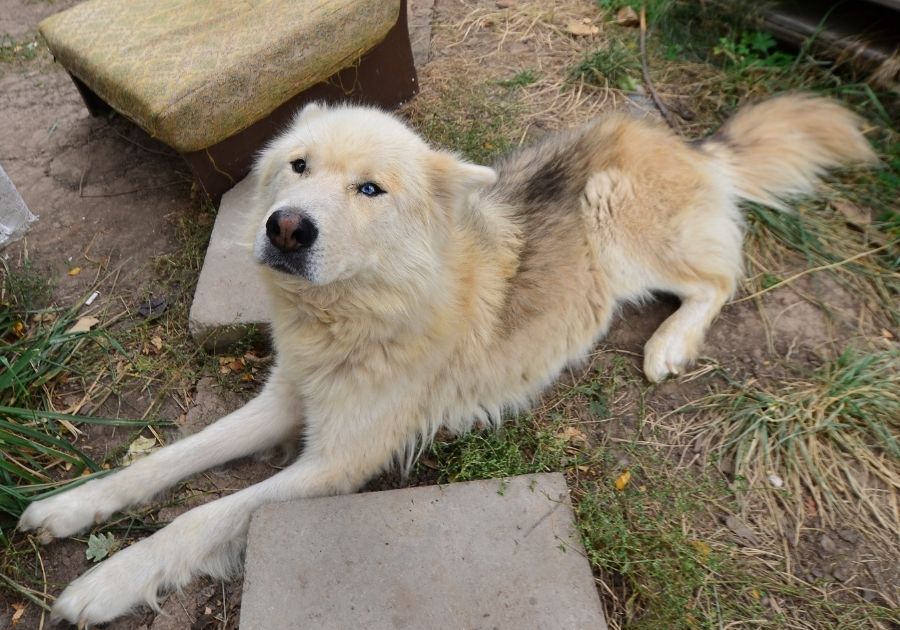
How big does a Samoyed Husky get?
The Samoyed Husky mix is a medium-sized breed, just like its parents. It weighs between 45 and 60 pounds and grows as tall as 20 to 24 inches at the shoulder.
How long do Samoyed Husky mixes live?
This mixed breed is a healthy one with a long lifespan. It can live up to 15 years and may even exceed that.
What is the best Samoyed mix?
There are many Samoyed mixes around. Some of the most popular ones include the Golden Sammy (Golden Retriever and Samoyed), the Samusky (Samoyed and Siberian Husky), and the Sammypoo (Samoyed and Poodle).
While they all have their strengths, the Samusky has the advantage of similar parents.
Are Samoyed Huskies good dogs?
Both the Samoyed and Siberian Husky are known to be good family companions with a low level of aggression and family-friendly qualities.
The hybrid is also a good dog, especially when well trained.
Conclusion
The exotic-looking Siberian Husky Samoyed mix is a designer breed might be your favorite, but you shouldn’t get one unless you know you can take care of it.
It has its needs and challenges, all of which make it a total package.
In the right hands, it is a loyal friend you would never want to let go of.
Related Mixes You May Also Like:
- Chihuahua Husky Mix
- Husky Bulldog Mix
- Dalmatian Husky Mix
- Shiba Inu Husky Mix
- Great Pyrenees Husky Mix
- Beagle Husky Mix
Reference:
AKC: Samoyed Dog Breed
DogTime: Siberian Husky Dog Breed

